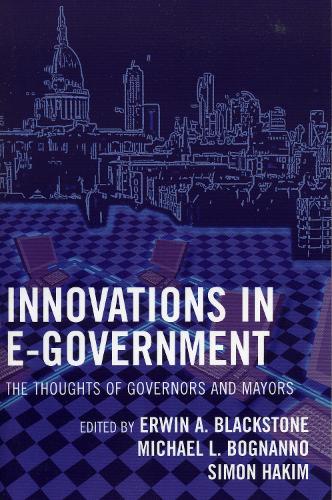
Innovations in E-Government: The Thoughts of Governors and Mayors
(Paperback)
Publishing Details
Innovations in E-Government: The Thoughts of Governors and Mayors
By (Author) Erwin A. Blackstone
Edited by Michael L. Bognanno
Edited by Simon Hakim
Contributions by Kay Barnes
Contributions by Erwin Blackstone
Contributions by Michael Bognanno
Contributions by Dave Bronconnier
Contributions by Lee Brown
Contributions by Willie Brown
Contributions by Jeb Bush
Bloomsbury Publishing PLC
Rowman & Littlefield Publishers
29th September 2005
United States
Classifications
General
Non Fiction
352.3821302854678
Physical Properties
Paperback
312
Width 159mm, Height 228mm, Spine 23mm
454g
Description
In Innovations in E-Government, Erwin A. Blackstone, Michael L. Bognanno, and Simon Hakim make the case that E-government is expected to make middle management of lesser value and flatten the pyramid of management in government. Improved communications, measurability of output, and the greater accountability of workers will reduce the necessary level of worker supervision and reduce the need for middle management. In turn, decisions by top management become more transparent and their accountability will also rise. Thus, as a result of improved technology, government could become leaner. Workers will be more empowered, efficient, and accountable.
When considering the long term effects of e-government on the structure and activities of government, increased transparency becomes a most beneficial aspect. When activities are reported, meetings are broadcast and information is easily accessed, citizens become more informed. This will make government more accountable and good governance in one locality will increase the pressure on others to also adopt the same innovations.
E-government is a technological innovation and moves from an inefficient and mainly unaccountable bureaucracy to a new entrepreneurial and accountable culture. It enables workers at lower levels of the hierarchy to take part in and be accountable for decision-making. E-government is being used to improve the management of cities and to achieve a more efficient use of resources. In the long run, opportunities exist for e-government to bring about a reorganization of government, one that would reduce excessively bureaucratic processes and organizational structures. It is these changes that may ultimately bring the biggest cost savings to taxpayers.
Reviews
Innovations most effectively communicates that e-government can structurally improve public-sector operations and services using anecdotal experiences from governors and mayors around the country who describe their own experiences with making government more e-friendly. ... High-profile essays from the likes of Jeb Bush, Mark Warner, Rudy Giuliani, Willie Brown and Mark Forman share space with equally interesting and/or applicable overviews from lesser-known officials. Authors were chosen for their commitment to e-government implementation and relative success in doing so. Most are forthcoming with their management and information-gathering strategies at each stage of execution. -- Alison Lake * Public Cio *
Author Bio
Erwin A. Blackstone is professor of economics at Temple University and a senior research associate at the Center for Competitive Government at Temple University.
Michael L. Bognanno is associate professor of economics at Temple University.
Simon Hakim is professor of economics and director of the Center for Competitive Government at Temple University. He has co-edited more than a dozen books on crime and public safety, privatization and several on best practices of governors and mayors including The New Public Management: Lessons from Innovating Governors and Mayors (2002), and Making Government Work: Lessons from America's Governors and Mayors (2000).
